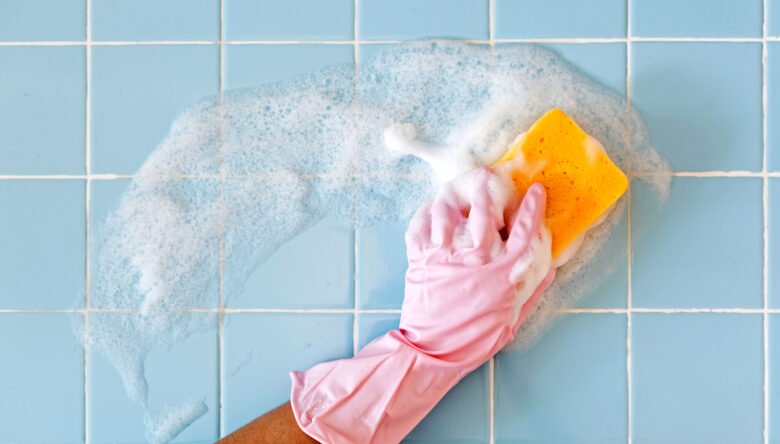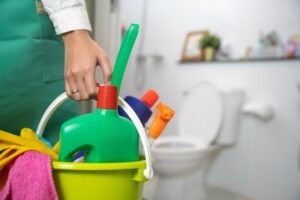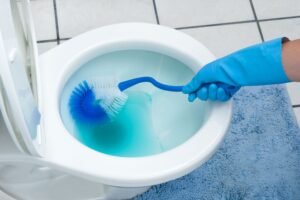Keeping toilets clean and stain free is essential to maintain a hygienic and comfortable atmosphere. Stains can be caused by a variety of chemicals and can be very difficult to remove if not treated properly. In this article, we take a look at effective bathroom stain cleaning routines to keep your bathroom looking its best.
The importance of stain removal
Not only do stains make the toilet look dingy, but they also harbor bacteria and germs that pose a health risk. Regular stain removal is essential to prevent the growth of harmful bacteria and maintain a clean environment for users. In addition, removing stains as quickly as possible helps to preserve the life and beauty of toilet surfaces.
Common Stains in Washrooms
Due to the range of chemicals that come into contact with the surfaces, toilets are susceptible to various forms of staining. Soap scum, hard water stains, rust stains, urine stains, mold and mildew, and grout stains are all common stains. To effectively remove any stain, certain techniques and materials are required.
Prepare the Surface
It is critical to thoroughly prepare the surface before you begin stain removal. Remove dirt or loose dirt with a soft brush or cloth. This stage allows the stain removal method to address the underlying problem without being hindered.
General Stain Removal Tips
There are some common tips that can be used for most stains. Begin by trying the stain removal method on a small, inconspicuous area to confirm that it will not harm the surface. When using cleaning products, it is also suggested that gloves be worn and that adequate ventilation be provided. Always follow the directions on the cleaning goods and avoid mixing chemicals unless specifically stated.
Removing Specific Stains
1. Soap Scum:
Soap scum can build up on bathroom surfaces and leave a filmy residue. Mix equal parts white vinegar and water in a spray bottle to remove soap residue. After spraying the solution on the affected area, let the solution sit for a few minutes. Scrub the surface with a non-abrasive sponge or brush, then rinse thoroughly.
2. Hard water Stain:
Mineral deposits left behind after the water evaporates can cause hard water stains. Soak a washcloth or sponge in white vinegar and place it on the affected area to remove hard water stains. Let it sit for a few hours or overnight. Scrub the surface lightly and the stains will begin to disappear. Rinse thoroughly after removing the stain.
3. Rust Stains:
Rust stains, especially on metal surfaces, can be difficult to remove. Make a paste with equal parts lemon juice and borax. Let the paste sit on the rust for a few hours. Scrub the area with a brush, then rinse thoroughly. Repeat the process if necessary.
4. Urine Stains:
Urine stains are not only unsightly, they can also smell bad. Remove the urine stain by first dabbing off excess liquid with kitchen paper or a cloth. Apply a solution of equal parts water and hydrogen peroxide to the stain. Let it sit for a few minutes and then pat the area again. Rinse the surface thoroughly and repeat if necessary. Enzyme cleaners made specifically for pee removal can be beneficial for stubborn urine stains.
5. Mold and Mildew:
Mold and mildew thrive in moist environments, so toilets are a welcome breeding ground. To remove mold and mildew, mix equal parts water and bleach or hydrogen peroxide. Let the solution sit on the affected area for a few minutes. Use a brush or sponge to scrub the surface, paying particular attention to any joints or cracks. Rinse vigorously to remove any residue.
6. Grout Stains:
Grout stains can build up over time and make the entire restroom appear unclean. Begin by making a paste of baking soda and water to remove grout stains. Allow the paste to sit for a few minutes on the discoloured grout lines. Scrub the grout with a toothbrush or a grout brush, then thoroughly rinse. Consider using a commercial grout cleaner or a mixture of hydrogen peroxide and baking soda to remove stubborn grout stains.
Natural Stain Removers:
Several household things can efficiently eliminate stains in restrooms if you prefer to use natural materials.
Baking Soda and Vinegar: Make a paste using baking soda and vinegar, then apply it to the stain. Allow it to remain for a few minutes before scrubbing and rinsing.
Lemon Juice: The acidic characteristics of lemon juice can aid in the removal of stains. Apply lemon juice straight to the stain, wait a few minutes before scrubbing and rinsing.
Hydrogen Peroxide: Hydrogen peroxide can be used to remove a variety of stains. Apply it immediately to the stain, let it sit for a few minutes, scrub if required, and then rinse.
Salt and Lemon: Apply a paste of salt and lemon juice on the stain. Allow it to stay for a few minutes before gently scrubbing and rinsing.
Borax: Make a paste of borax and water and apply it to the discoloration. Allow it to sit for a few minutes before scrubbing and thoroughly rinsing.
Tea Tree Oil: Apply tea tree oil to the stain after diluting it with water. Allow it to remain for a few minutes before scrubbing and rinsing.
Preventing Stains:
The key to keeping washroom surfaces clean is prevention. Here are some preventive steps to think about:
Regular cleaning: Implement a regular cleaning program to eliminate probable stain-causing substances before they get deeply embedded.
Ventilation: Proper ventilation reduces moisture levels, reducing the growth of mold, mildew, and other stains.
Surface protection: To make washroom surfaces less stain-prone, consider applying a sealer or protective coating.
Prompt action: Clean up spills and stains as soon as possible to avoid them setting and becoming more difficult to remove.
Conclusion
Effective stain removal solutions are critical to keeping washrooms clean and hygienic. By following the advice and procedures in this article, you can combat many stains and prevent them from affecting the cleanliness and appearance of your toilet. Always test on a small area before applying more widely, and use the correct method for your specific stain and type of surface.
Frequently Asked Questions:
1. Can I use bleach to remove stains off toilet seats?
Certain stains, such as mold and mildew, can be removed with bleach. However, because bleach is abrasive and can damage sensitive surfaces, it must be used with caution and in accordance with the manufacturer’s recommendations. Always test a small area before using bleach on a wider scale, and use it with sufficient ventilation.
2. Natural Stain Removers: Are They As Effective As Chemical Cleaners?
Natural stain removers are safer alternatives to harsh chemicals and help with many common stains. However, their effectiveness may vary by stain and surface. It is always a good idea to start with a small area and adjust the program or try a new approach if necessary.
3. How do I prevent soap residue in the bathroom?
Wipe the surface after each use to avoid soap residue. Using liquid soap instead of bars can also help reduce soap scum. To make cleaning easier, lubricate the surface with a wax or a special soap-based anti-scale agent.
4. What can I do to prevent limescale in my bathroom?
Consider purchasing a water softener or building a water filtration system to prevent limescale build-up. Regularly wiping the surface with a vinegar solution will also help dissolve and prevent mineral deposits. By drying the surface with a squeegee or towel after each use, you reduce the risk of wet spots and stains.
5. Are there natural ways to prevent mold in the bathroom?
Yes, there are natural ways to prevent mold. Use exhaust fans or open windows for proper ventilation. Use a dehumidifier or install a ventilation system to keep humidity levels low. Surfaces should be cleaned regularly with a solution of vinegar or tea tree oil, as these natural ingredients have antimicrobial properties.



